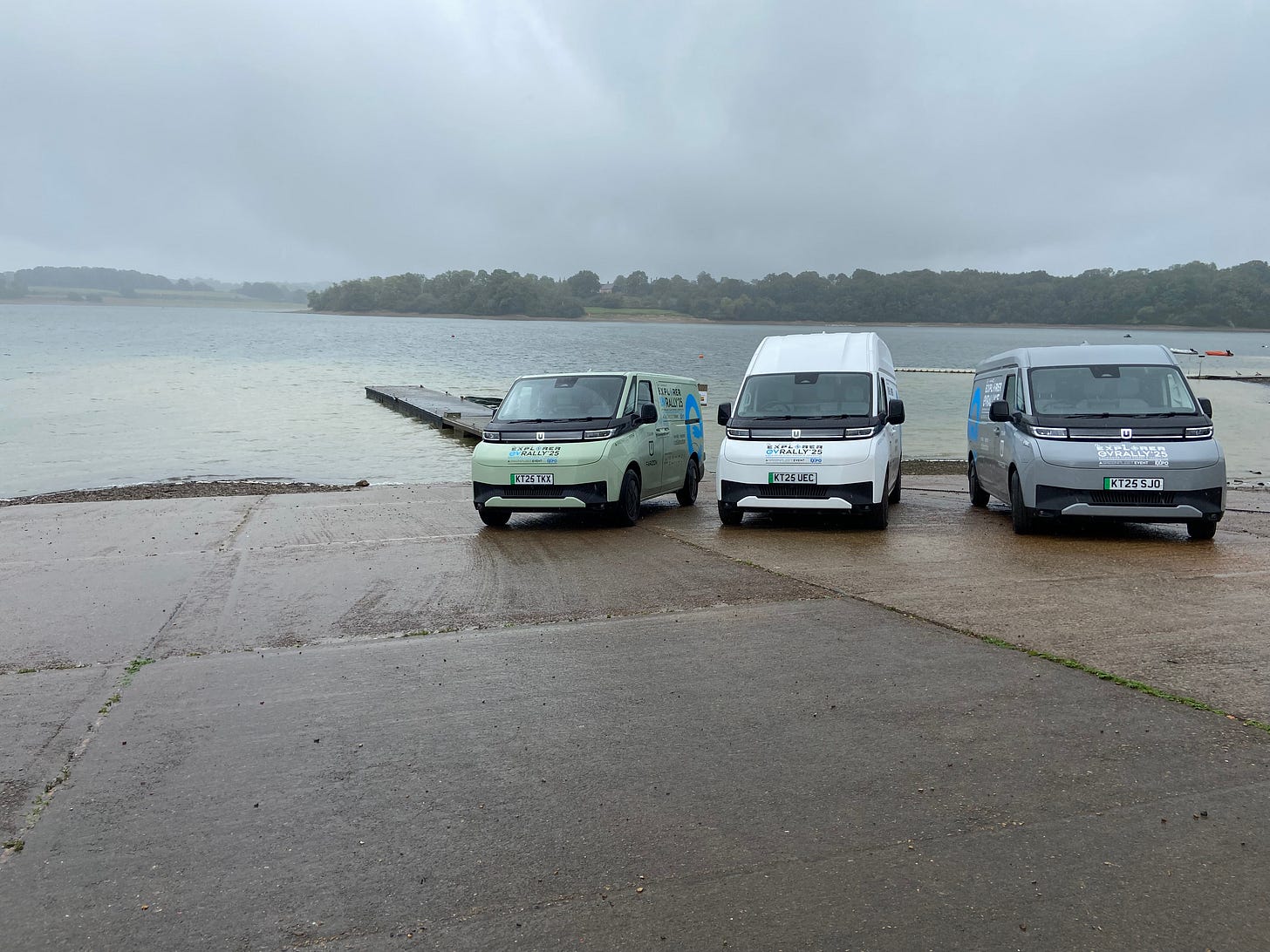I had the excellent opportunity recently to partake in the Greenfleet EV Rally. Thanks to the good folks at Farizon I was provided with my very own Farizon SV electric van for the day (It’s the grey one on the right in the photo above). I managed to cover over 200 miles travelling across various roads from motorways to dual carriageways, A-roads, B-roads and even single track roads with passing places.
Having driven vans during lockdown as a grocery delivery driver I was keen to understand where the 'state of the art' had moved to in the last five years. A Mercedes diesel sprinter to an electric van. It was a chalk and cheese.
The van performed flawlessly averaging around 2.8miles per kWh. That might seem a bit inefficient when compared with things such as the Hyundai Ioniq 38kWh ‘Windknife’ But this was an L2, H2 type van meaning it was quite tall, quite long and not, particularly, efficient.
Not helping matters was the horrendous rain and a rather nippy sport mode which was much more fun that it needs to be in a van. World-record holding efficiency driver Kevin Booker was in a similar- but smaller - version of the van and achieved a value slightly better at around 3 miles per kWh.
Naturally the Farizon van was quieter, smoother and had better performance than my old diesel van. With a decent size battery (83kWh) and a charging speed up to 140kW in the version I had, time at the chargers was mandated more by the activities we were doing in parallel rather than the actual van itself. In this case the parallel activities were putting together some footage, grabbing coffee and - in one case - grabbing a nice McPlant meal. At no point was I waiting for the vehicle to charge.
Did the van have downsides? Yes. The current version of the software is quite early in development and is missing a couple of key things. When charging, for example, there is no way of viewing data on the current range of the van. You can see the percentage state of charge, and you can see how long until the charge completes at 100%. But there's nothing to say 'with the charge you currently have you can cover around 110 miles'. That's being fixed in an upcoming software release. There’s also all the usual bings a bongs you’d expect from a Chinese brand, although they have been toned down a lot for the UK market.
It has driver monitoring software too so it can warn you if you’re not paying attention while driving.
One other thing I'd love to see is a more detailed screen showing consumption and efficiency. At the moment there's a single figure shown in the driver's binnacle displaying the current efficiency in kWh/ 100 miles (!). There's nothing that indicates how that figure was derived (drivetrain vs air conditioning vs other sources), nor over what distance that efficiency was calculated. Is it updated every mile? Every 5 miles? Does it refer to the efficiency over just the last 5 miles? The last 10? The last 100? Hard to say.
There are other little quirks such as the fact that it is one of the only EVs I've been in that doesn't have an on-board navigation system. You are expected to provide your own via Apple CarPlay. No Android Auto (although that is coming soon, I'm told).
The downside to this is that you'll also need an app to locate and navigate to chargers if needed. Zapmap, of course, is the logical answer for this and - with a premium subscription - this will provide CarPlay integration. Sure, you can use Google to navigate to chargers, but the filtering for suitable CPOs, connectors and hubs is not there yet, meaning you could end up at an unreliable single-unit GeniePoint that isn't working when you really want to be somewhere like a Fastned or Osprey Charging hub.
Did I have other gripes? One or two. The cup holders are not very well thought out. There are no ‘cup-sized’ cup holders in the van. There are a couple that will take a 1-litre bottle of water. But a take-away Costa coffee (or even one poured into your favourite reusable coffee cup)? No. Too big. Also the cup holder in the door is far too low down to be of any practical use. Farizon have received this feedback and are working on a solution.
Secondly the seat. It has two degrees of movement: forwards/ backwards, and recline. There is no height adjustment. With the steering wheel being mobile in one direction only (rake) this means that to get a comfortable driving position is a trade-off between having to drive with hands lifted high to hold the steering wheel, or having hands in a comfortable position but driving without the ability to see a large proportion of the driver’s display binnacle. Again, Farizon are aware of this and are working on a solution.
The Farizon van comes in multiple variants with two different battery sizes (67kWh and 83kWh). Prices start at £45,000 OTR ex VAT - although these prices will be slightly lower after applying the Electric car grant. The version I was in was £51,000 OTR ex VAT and grant. Bigger batteries give more range (214 miles WLTP) but decrease payload (1,160kg). Smaller batteries give shorter range (177 miles WLTP) but allow you to carry more (1245kg). The weight of the battery accounts for the difference in payload.
It’s very encouraging to see where electric commercial vehicles are going at the moment. Farizon is a relatively new brand to the UK market but their product is starting off on the right foot and they appear to be very open and receptive to requests for update, turning them around quickly.
Thanks to Jamie Fretwell and his team at Farizon for putting me in one of their vans for the day.


